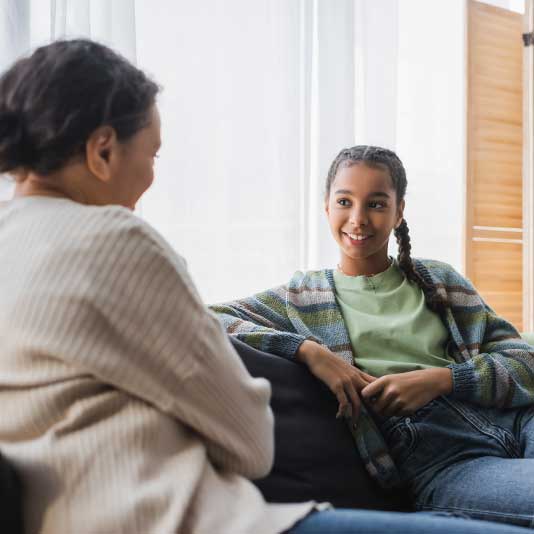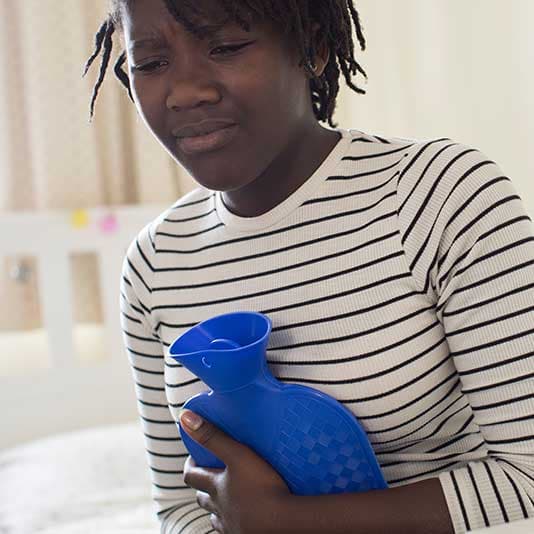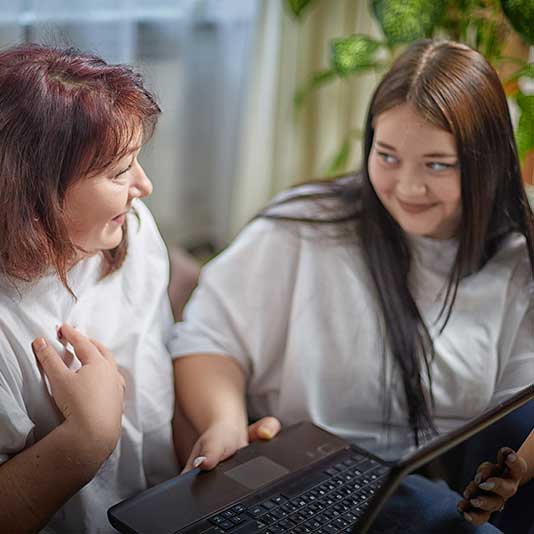A beginner's guide to menstruation
The lowdown on getting your first period, and how to support and talk to adolescents about menstruation.
What is a period?
A period is the name for the release of blood from the vagina each month. As part of the menstrual cycle, an egg is released from one of the ovaries, along the fallopian tube into the uterus. During this time the lining of the uterus is thickening in preparation for a fertilised egg. If no fertilisation occurs, the egg breaks down and the uterus lining sheds, creating the bloody fluid and tissue that flows out through the vagina, this is known as menstruation, or more commonly, a period.
When does it happen and how often?
The average age for girls to get their first period is 12 years but some may get them much earlier or later (between the ages 8 - 16 years).
Periods tend to last for five days, but they can be longer or shorter. Everyone is different. Your first period can be quite light in flow, and it may take some time for them to become regular. It’s important to understand flow can vary when your periods are regular too, you may experience heavier days and lighter days during the same cycle.
The average menstrual cycle is 28 days, but some women have much shorter cycles of 22 days, or longer - up to 36 days. These are all normal ranges, and in time you will learn what’s normal for you.
After about 18 months to two years your period should have settled into a regular and more predicable pattern. You may find it useful to log them in a calendar or on a period app to help you track your cycle.
Be prepared
It’s hard to know when your first period will start or indeed your second, third or fourth, if they haven’t settled yet. So, it’s best to be prepared and look out for signs.
Maybe some of your friends have got theirs, or you’ve been noticing other changes in your body from puberty like pubic hair, or breast growth. These can all be signs that your body is getting ready for your period, but you won’t be able to pinpoint it to a day.
If you feel comfortable, speak to a parent or an older sibling about buying some period products so that you have some at home, and perhaps carry a pad or panty liner in your bag in case you are caught by surprise. Don’t worry if you do get caught out many public toilets and school toilets have sanitary product vending machines, you could also visit the school nurse, who could give you a pad for free if you’re in need.

What can I use?
There are a variety of period products on the market, designed to suit a range of flows. You may want to try out a few different products to learn what feels most comfortable for you. There are essentially three main types of feminine hygiene products; sanitary pads/ panty liners, tampons, and menstrual cups.
Deposable pads and liners are designed to be placed in the lining of your underwear, they have a sticky backing to keep them in position and need changing after a few hours. There are lots of options including ones with wings and longer ones for night-time wear and heavier flows. Panty liners are smaller and thinner and can be useful for the tail end of your period or for added prevention against leaks when wearing a tampon or menstrual cup.
Tampons are a narrow absorbent plug that you insert into your vagina to absorb your period blood before it flows out. They can take a bit of practice to insert. Some come with applicators to make inserting a little easier. A benefit of tampons is they’re more discrete and less likely to be seen through tight clothing. They can also be worn for swimming. Like with sanitary towels they need changing after a few hours.
As with tampons, menstrual cups are also inserted into your vagina, and it can take some practice to get the knack. Often made of silicon they collect the blood in the cup which you then empty away down the toilet. After a quick clean you can just reinsert. Menstrual cups are quite a low cost and sustainable option as they can last up to 10 years.
PMS (premenstrual syndrome)
As your body prepares for your next period, fluctuations in your hormone levels can cause emotional and physical changes known as premenstrual syndrome (PMS) or premenstrual tension (PMT). However, not all periods or people have PMS.
There isn’t a definitive list of PMS symptoms, but the most common ones to be aware of are bloating or feeling bloated, breast tenderness, feeling irritable, frequent changes in mood, and skin breakouts. These symptoms usually improve once your period starts and stop a few days later.

Period pain
When you get your period it could also be accompanied by some discomfort or mild to moderate pain. This is because as your body prepares for your period, it contracts your uterus to help shed its lining. These little contractions can cause abdominal cramps, which can sometimes also be felt in your thighs and back. It’s completely normal to experience period pain and it’s a common side effect of menstruation. Cramps can last for two or three days, from the start of your period and tend to lessen after your heaviest bleeding days. It is not actually known why some women experience more period pain compared to others, it is thought that some women have a build-up of prostaglandins, meaning that these women experience stronger contractions.
There are several things you can try to help alleviate the symptoms.
Take some gentle exercise, go for a walk or cycle. Although you might just feel like curling up into a ball under the duvet, being active can help to reduce the pain
Pop a hot water bottle on your tummy, back or wherever the pain is. The heat can help relax your uterine muscles and ease the cramps
The effects of having warm bath or shower work, in much the same way, with the raised temperature easing the contractions and discomfort
Lastly taking ibuprofen or paracetamol can also help with pain relief.
Medical conditions that may cause period pain
Period pain, less commonly, can be caused by an underlying medical condition. Some medical conditions that may cause period pain are:
Endometriosis
Where the cells that normally line your womb start to grow in other places such as the ovaries, this can cause intense pain when the cells shed.
Fibroids
These non-cancerous tumours grow in the womb or around the womb and can make your periods very heavy and painful.
Adenomyosis
This is where the tissue that is lining the womb begins to grow within the muscular womb wall and can make periods very painful.
Pelvic Inflammation Disease
The womb, fallopian tubes and ovaries all become infected with bacteria which makes them inflamed, causing painful periods.
It is important to see your GP if you have severe period pain, bleeding between periods, if your periods become heavier or if they start to become irregular. Periods can change and sometimes they last longer or become lighter over time. This doesn’t necessarily mean that there is something wrong, but it is always worth speaking to your GP about any concerns.
How to approach the topic of periods as a parent or care giver
Talking to your child or any pubescent teenager about periods probably isn’t at the top of anyone’s ‘to-do’ list, but it’s an important conversation to have and to approach it in a way that feels comfortable for both of you. The menstrual cycle is natural and happens to 50% of the population. Try to be confident and open about periods and period hygiene, this will help her feel more prepared and confident in what to do when her menstrual cycle begins.
Ideally, it’s not just one big chat, but part of an ongoing conversation about our bodies and growing up that you’ve been building on for a little while. But if you haven’t been doing that then don’t worry, it’s never too late to begin.
Don’t wait until her period starts to begin talking about it. Remember some girls can start their period as early as eight years old, although the average age is 12. Help her to feel prepared. She might feel anxious and embarrassed about what’s to come. Reassure her that periods are a completely natural, normal part of growing up.
Look for opportunities to introduce the subject, perhaps after seeing an advert for sanitary products or a positive story in the news or on social media about periods.
